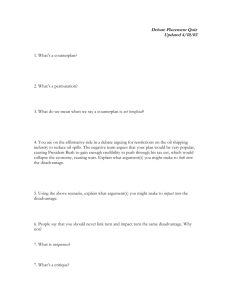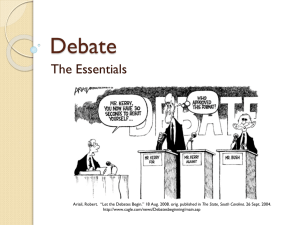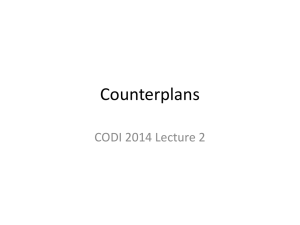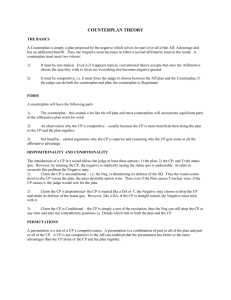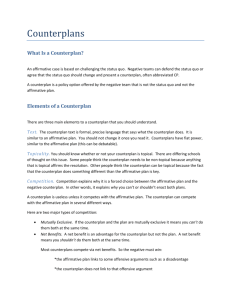counterplans
advertisement
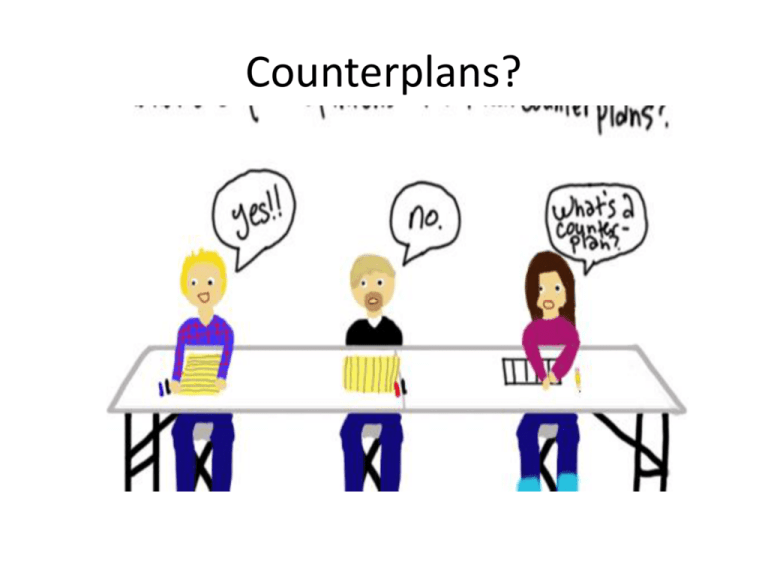
Counterplans? • Debate should be a means of significantly improving one's education through analytical development and extension of advocacy positions. The negative strategy of counterplan would seem to be highly congruous, if not essential, with that ideal. -- Steve Mancuso – University of Kentucky, 1981 Definition • A counterplan is a proposal introduced by the negative that is not the affirmative plan and not the status quo. The negative argues that the counterplan is a superior alternative to the plan. The affirmative argues that the plan is a superior alternative to the counterplan. A Counterplan Is • An argument read by the negative in the 1NC • A proposal for change — important that it is not the same change as the affirmative. • • Competitive with the affirmative plan — the negative must force the judge to choose between the plan and the counterplan. • • An opportunity cost of the affirmative plan -The negative’s goal is to persuade the judge that the costs of foreclosing the option of the counterplan outweigh the benefits of enacting the plan. • • A strategic tool for the negative — the counterplan is a powerful weapon in the negative’s arsenal. It allows the negative to control the debate: they can concede that there are problems with the status quo but still argue that the plan is a bad idea. Strategic Value • Sometimes the status quo is indefensible — affirmative teams tend to be strong at pointing out problems with the status quo but weak at identifying effective solutions. • They allow the negative to control the focus of the debate — the affirmative has control at the beginning of the debate because they get to choose their plan and advantages, forcing the negative to react. Counterplans give the negative a chance to claim some control by introducing their own proposal for change. • • They allow the negative to narrow the debate — many counterplans arguably solve the whole affirmative case. The negative can therefore use a counterplan to narrow the debate: instead of defeating Advantage 1 and Advantage 2, the negative can simply argue that the counterplan solves Advantage 1 and Advantage 2. Anatomy of a Counterplan • Text — like the plan text, this is simply the proposal being introduced by the negative. It is read at the beginning of the counterplan shell in the 1NC. • • Solvency — evidence needs to be presented that the counterplan solves the case. This evidence is read after the text of the counterplan in the 1NC. • • Competition — the negative needs to explain why the counterplan competes with the plan. This is sometimes done immediately after the text of the counterplan and sometimes after the solvency evidence is introduced. • 2 Ways to Compete • Mutual Exclusivity — this is a fancy way of saying that the plan and the counterplan cannot be done simultaneously, not just that it is a bad idea to do them simultaneously. • • Net-Benefits — this means that there is a disadvantage to doing the plan alone or the plan and counterplan together that doing the counterplan alone avoids. While it is possible to do both the plan and the counterplan at the same time, the negative argues that doing the counterplan alone is the best option. Net Benefits Internal – the beneficial result is tied directly to the action of the cp (example: consulting the European Union generates better relations with the United States) External - can function as a disad on its own (avoids the link to politix) Counterplan Competition • Textual competition: strict reading of the plan text vs. strict reading of the CP text • Functional competition: what the plan actually does: clarification of the plan text, determined by CX explanation and by evidence. Generic versus Specific It’s good to have both generic CPs prepped as well as specific ones Generic Counterplans apply to most affs Specific Counterplans are for a particular plan and usually lead to more clash and detailed debate Example • • • • • • • • • • • Advantage: I love Taylor Swift and wants to listen to her music and support everything she does Plan: I should buy all of Taylor Swift’s music on iTunes Disadvantage – buying all of Taylor Swift’s music will cost $9,000 If I want to listen to Taylor Swift, it would be a better idea to just stream it on Spotify (the counterplan) What Makes It Better? • Avoids the disadvantages to doing the plan • Streaming on Spotify would be free so I save $9,000 • Solves the advantages to doing the plan • I will be able to listen to Taylor Swift music and support her Permutations • In order to test the competitiveness of a counterplan, the affirmative can introduce a permutation in the 2AC. A permutation is a combination of the plan and counterplan; the most basic permutation is all of the plan and all or part of the counterplan. • • The goal of a permutation is to demonstrate that the plan and the counterplan could be simultaneously adopted and that this combination is as good as or better than adopting the counterplan alone. It is like a “no link” argument against a disadvantage; it asks the question “Why can’t we do both?”. Status of Counterplans • The negative does not need to commit to extending a counterplan in the 2NR when it is introduced in the 1NC. In many cases, the negative will want to maintain the option either to extend the counterplan or to extend their attacks against the case. This gives the negative a multi-faceted strategy for defeating the affirmative as the debate evolves. • • In order to preserve the option of defending the status quo instead of the counterplan, the negative needs to defend their right to “kick” the counterplan. Whether and under what conditions it is acceptable to kick a counterplan is a debatable issue. In general, the negative will want to retain the right to revert to the status quo instead of the counterplan while the affirmative will want the negative to have to choose which option they will defend at the beginning of the debate. • 3 Types of Status • • • • • • • • The question of whether the negative can kick a counterplan is the question of the counterplan’s status (or disposition). The affirmative should ask in the cross-examination of the 1NC for the status of the counterplan (“What is the status of the counterplan? Under what conditions can the negative revert to defending the status quo?”). The negative can choose one of three possible responses: The counterplan is “Conditional” — this means the negative can revert to defending the status quo at any time. This is the most flexible status for the negative because it gives them the option of going for either the counterplan or the status quo. The counterplan is “Unconditional” — this means the negative cannot revert to defending the status quo and must go for the counterplan. This is the least flexible status for the negative because it locks them in to choosing between the counterplan and the status quo in the 1NC. The counterplan is “Dispositional” — this means the negative can revert to defending the status quo at any time unless the affirmative “straight turns” the counterplan. While this is a complicated concept, it basically means that the negative only has to give up the status quo if the affirmative concedes the “link” to the counterplan. Types of Counterplans Agent CPs • Agent counterplans. An agent counterplan is a counterplan that uses a different agent than the affirmative does. • Example: Plan: The United States federal government should distribute Taylor Swift CDs to high school debate classes • Counterplan: The United States Supreme Court should rule on X relevant test case that Taylor Swift CD’s should be distributed to high school debate classes PICs • Plan inclusive counterplans. A plan inclusive counterplan or “PIC” is a counterplan that does one or more parts of the affirmative’s plan and argues that the part, or parts, that it doesn’t do are bad. • Often very strategic; on this topic people will probably PIC out of particular agencies • Example: Plan is to distribute Taylor Swift CDs to schools; counterplan is to remove out of one school where 90% of students already listen to Taylor Swift Process Counterplans • Process counterplans. A process counterplan implements the affirmative’s plan through a different process than the negative uses. Most of these counterplans claim that they are different than process the affirmative uses – fiat, which according to modern understandings, passes the plan unconditionally and forever. Process CPs Example • Plan: United States Federal government should play Taylor Swift in its all federal government buildings • Counterplan: The United States federal government should institute a referendum concerning whether Taylor Swift should be played in all its federal government buildings Uniqueness Counterplans • Uniqueness counterplans. These are the most difficult counterplans to understand and these counterplans are presented by the negative far less frequently than any others. The basic idea behind a uniqueness counterplan is that the negative can run a counterplan to make the disadvantage unique. • For example, say the negative runs a Spending disadvantage and the affirmative says, “Non-unique – We are about to spend another $80 billion” in Iraq. The negative says, “Counterplan – don’t spend that $80 billion in Iraq.” The negative will argue that their counterplan is net-beneficial because it is undesirable to spend money (they save money relative to the status quo) and that the permutation to do both still involves the plan spending money, which is bad. Consult CP • Consult CPs basically say do the entire aff but consult a country or entity first • Example– Plan: Lauren should play Taylor Swift music all day long – Consult CP: Lauren should consult her roommate about playing Taylor Swift music all day long (with the net benefit of her roommate’s sanity) Consult CPs Why might the consult counterplan not be the best counterplan? 1) You could literally consult any country in the world (although the negative will say that lit checks- there is not information on consulting Estonia about surveillance) 2) Not really textually competitive- just adds the words “consult X” to the plan text 3) Not functionally competitive- no specific evidence about consulting a particularly country about our plan Advantage CPs • These try to solve the advantages of the aff through a different mechanism • Example- the plan is to reduce surveillance for deportation, detention, and raids (immigration essentially) with the advantage of the economy • What might be a better way to solve the economy? Affirmative Answers to CPs • Introduction (STOP) • When answering a counterplan, the affirmative has four basic options: Solvency, Theory, Offense, and Permutation (STOP). As when debating against disadvantages, the affirmative should introduce several arguments in the 2AC and selectively extend some but not all of them in the 1AR and 2AR. The overarching goal is to prove that the plan is better than the counterplan, but the specifics vary depending on the argument being extended. Answering CPs- STOP • Solvency • This is the most basic response to a counterplan. In the same way that the negative challenges the solvency of the affirmative plan, the affirmative should challenge the solvency of the negative counterplan. Solvency arguments need to be comparative and specific to the counterplan. Attacks that apply both to the plan and the counterplan are not helpful because they do not help the affirmative prove that the plan is better than the counterplan. STOP • Theory • The affirmative can argue that a counterplan is theoretically illegitimate—either because it exceeds the appropriate scope of negative fiat or because its status is unfair to the affirmative. These arguments are discussed in more detail on the “Counterplan Theory” page of this handout. STOP • Offense • In the same way that the negative can read disadvantages against the affirmative plan, the affirmative can read disadvantages against the negative counterplan. These disadvantages need to be specific to the counterplan; as with solvency arguments, disadvantages that link to both the plan and the counterplan are not helpful because they do not prove that the plan is better than the counterplan. STOP • Permutation • A permutation argues that the plan and counterplan could be enacted together and that doing so would be a better option than doing the counterplan alone. Common Permutations • The Classic Permutation – Do Both • The Logical Permutation - all of plan and the logical parts of the counterplan. • Perm Do the CP Abusive Permutations • Severance Permutations - Do part of the aff plan and all or part of counterplan • Intrinsic Permutations – Do the plan, all, part, or none of counterplan, and an action found in neither the plan nor the counterplan. • Time Frame Permutations - any of the above permutations that also changes the time of adoption of the plan or counterplan (usually “delay” counterplans) Extending CPs • Introduction • The negative’s goal when extending a counterplan is to prove that the counterplan alone is a better option than the plan or the combination of the plan and the counterplan. To do so, they must defeat the affirmative’s solvency, theory, offense, and permutation arguments. Extend Like a DA • Extend Like A DA • The extension model for a counterplan in the negative block is very similar to the one used to extend disadvantages. As an overview, explain what the counterplan does and why it is net-beneficial. Then answer each of the 2AC’s arguments in the order that they were made by referencing them, extending 1NC evidence, and reading additional evidence. For example: • • 2AC #1—they say “permute — do both,” but this links to the Election DA— Obama would still take the blame for federal spending, costing him the election. Only the counterplan alone avoids this disadvantage. Additionally, the permutation fails to promote state innovation: it forces states to follow the federal government’s lead instead of allowing them to be laboratories for infrastructure—that’s Edwards. • Extending a CP • Identify A Net-Benefit • Don’t forget that In order to be viable, the Counterplan needs a net-benefit. • Say CP solves 100% of the case” OR • “CP solves X advantage and the net benefit turns the other” – 20-30 seconds on why • 30 seconds on the net-benefit explanation – impact calc Counterplans on this Topic • Predictions? Surveillance Counterplans • The states counterplan is functionally not a thing on this topic because only the federal government can regulate surveillance • Agent Counterplans- If the Affirmative specifies their agent (courts, legislative, executive), the negative could counterplan to use a different agent and read disadvantages that to the agent the Affirmative specifies. For example, if the Affirmative uses the courts (usually the Supreme Court) as the actor, the Negative could counterplan to have Congress amend the constitution and then read court disadvantages Surveillance CPs • Advantage counterplans. Teams will read counterplans to solve the advantages through other means, such as strengthening the economy to promote hegemony and closing Guantanamo Bay, Cuba to boost US soft power. They will then read disadvantages that are specific to the surveillance curtailment in the plan as net-benefits. Surveillance CPs • Private Sector. The private sector is capable of undertaking many actions that work to protect privacy. Surveillance CP (PCLOB CP) • Privacy and Civil Liberties Oversight Board • This is basically a board which independently ensures “that concerns with respect to privacy and civil liberties are appropriately considered” in making laws to fight terrorism 1NC text- PCLOB • Text: The United States federal government should propose <the plan> to the Privacy and Civil Liberties Oversight Board for review. The board should solicit input from all relevant stakeholders. The board should recommend that the United States federal government <do plan>. PCLOB CP • The counterplan does NOT fiat that Congress will implement the plan but rather due the board’s recommendation will build enough momentum in congress to create effective institutionalized reform PCLOB CP • Net Benefit- doesn’t link to Politix because the board is a third party organization and completely independent which allows for them to garner support and coalition for the plan in congress and shields controversy. DISADVANTAGES • Argument introduced by the negative in the 1NC that identifies a new problem the affirmative causes DISADVANTAGES 1. Uniqueness – what is happening now 2. Link – how will the aff’s plan/policy change that 3. Internal Link- Connects the link to the impx 3. Impact – why is that change bad Example of a Disad • Lauren should eat 9 apple pies every morning • Advantage: apple pie makes Lauren happy • Neg: Lauren does not have infinite money Breaking Down the DA • If Lauren eats 9 apple crisp pies every day, she will run out of money 1. Lauren has enough money to pay for gas to get to school 2. Bad spending habits bankrupt her 3. A bankrupt Lauren can’t pay for gas to get to school 4. Bankrupt Lauren loses her job which leads to nuclear war Affirmative Answers to DAs 1. Non-unique – the DA is going to happen inevitably, even if we don’t do the plan – Lauren already can’t afford gas- she’s a teacher! Link Debate . No link – the plan doesn’t cause that change – Pies are very cheap 3. Link turn – the opposite of the link is true – Eating pies for breakfast means Lauren can skip lunch which saves her money No impact . No impact – the impact isn’t a big deal – Lauren doesn’t need gas money Impx Turn 5. Impact turn – the aff does, in fact, cause _____ but that’s a good thing – Not being able to afford gas means Lauren spends more time at home with her cat Caution • DO NOT Link Turn and Impact Turn • If you do this, you argue that the affirmative prevents a good thing from happening Questions? • My email is Ldonnen@gmail.com if you have questions that come up later too
